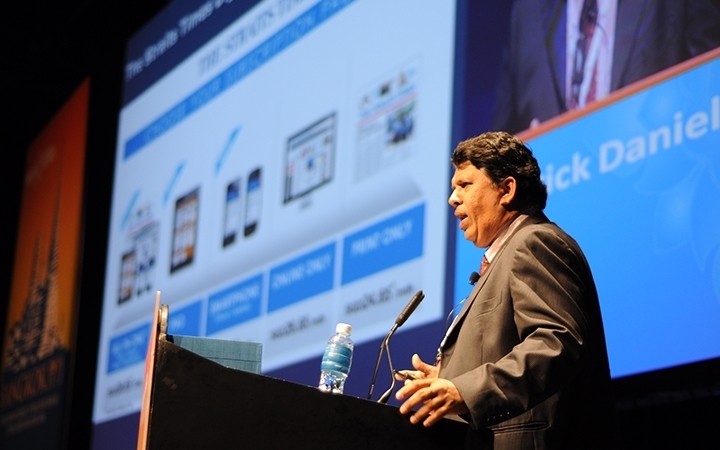
Looming competition from the internet reminds newspaper editor Patrick Daniel of a quote from Ernest Hemingway’s celebrated novel, The Sun Also Rises.
‘How did you go bankrupt?’ one character asked.
‘In two ways,’ another responded. ‘Gradually. Then suddenly.’
Daniel is editor-in-chief for English and Malay newspapers at Singapore Press Holdings (SPH), a formidable publishing machine that sells about a million newspapers a day – not bad for a city of just over 5 million people.
The margin for flagship title Straits Times, at around 35%, ranks among the highest of any newspaper anywhere in the world.
Nonetheless, the threat of disruption is never far away.
“As a newspaper editor having to guard a margin of about 35%, I can tell you it sometimes feels as if I’m standing on a very steep slope, and that one day I will wake up and be sliding down,” Daniel wryly remarked, speaking at this year’s global Wan-Ifra conference, held in Bangkok.
Online alternatives have already compacted newspapers’ share of ad revenue in mature APAC markets such as Australia and Japan, Daniel pointed out.
On a separate session at the conference, newspaper publishers from Southeast Asian growth markets discussed the diverse set of challenges facing them.
However, publishers in print strongholds such as Hong Kong and Singapore, where newspaper business models retain much of their traditional strength, still have a chance to articulate their value for a digital age, Daniel suggested.
Evidence of a new attitude comes from women’s magazine Cosmopolitan in the US, unveiling an iPad edition in February this year for US$19.99, nearly double the price of its print edition.

“I thought right, that’s exactly what we should be doing,” Daniel said.
SPH erected its first paywall about 10 years ago, in opposition to widespread sentiment at the time that content should be free.
Online access was still competitively priced, at about a third of the cover price for the print product.
However, the advent of smartphones and tablets has allowed SPH to close the gap, easing internal tensions over potential cannibalization of subscription revenue.
The next step could be further gains through more variable pricing on digital products.
“What we discovered is that we have regained our pricing power for digital subscriptions,” Daniel said.
“We can’t raise cover prices of our print products, but we can raise the price of our digital products.”
The paper’s perceived value among advertisers, however, is another story.
Digital ad sales can’t support the current cost base, forcing sometimes painful decisions on where cuts must be made.
A sense of how much pressure is starting to build became apparent in SPH’s latest quarterly results, announced in July after the Wan-Ifra conference.
Quarterly ad revenues were down S$9 million (US$7.1 million), a 3.3% year-on-year decline, largely due to belt-tightening among property and transport advertisers.
Circulation revenue also declined by S$1.2 million, a 2.3% drop.
“Singapore is a canary in the mine for digital impact on print,” speculates Bharad Ramesh, head of trading for Southeast Asia for Publicis Groupe’s buying arm, VivaKi.
“After many years, we finally saw ad revenue decline for SPH, and speedily go downhill.”
That could leave Malaysia as one of the best places in Asia to own a newspaper.
Despite lower readership than SPH, market leader Star Publications continues to have pricing power there, Ramesh points out.
Necessary transformation is underway at SPH, Daniel said, though not easy to implement, as it impacts both jobs and salary structures.
The main goal from an editorial perspective is building a multiplatform newsroom that is fit for the future.
At a broader business level however, executives face a more demanding challenge – sustaining profit levels as competition for readers and advertisers starts to intensify.
“Every acquisition is not accretive,” Daniel said. “It’s hard to find a business as profitable as newspapers, so we want to make sure that portion of our business remains high-margin.”
The 35% cushion enjoyed by Straits Times could be a double-edged sword.
“That makes my job 10 times more difficult,” Daniel added, “because I have to keep it there.”

As a leading independent consulting and research provider focused on Asia media & telecoms, MPA offers a range of customized services to help drive business development, strategy & planning, M&A, new products & services and research. Based in Hong Kong, Singapore and India, MPA teams offer in-depth research reports across key industry sectors, customized consulting services, industry events to spread knowledge and unlock partnerships, and publications that provide insights into media & telecoms.
All Media Partners Asia articles >Thank you for submission
Once you activate the account, your subscription entitles to receive 3 months of complimentary access to ‘The Digest’, MPA’s monthly email analysis,updates across TMT with exclusive industry interviews and data.